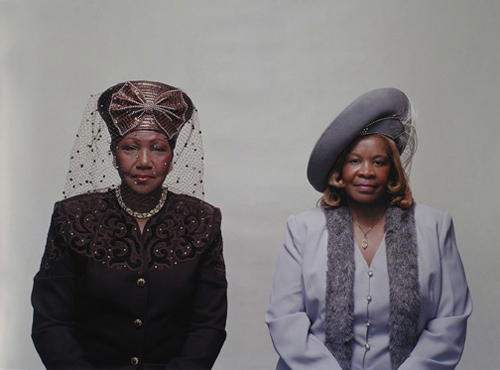Julie Moos, Canadian writer and photographer, captures a fascinating element of African-American culture in her latest exhibition at the Harvey Gantt Center, I Got Freedom Up Over My Head. Borrowed from the Bank of America Collection, these 2001 photographic portraits of pairs of women dressed in their Sunday finest effortlessly intrigue the viewer.
In this series Moos allows us to appreciate both the cultural and universal aspects of choosing fine adornment for the act of worship. The show recognizes that in some places, dressing up for Sunday services is not a lost art, and she praises those who still approach the ritual with fervor.
While living in Birmingham, Alabama, Moos was approached by local councilman and friend Elias Hendricks to photograph a group of fellow congregants at New Pilgrim Baptist Church called the Hat Ladies. The group of aging women, to which his mother belonged, were well-respected servants of the community whose essence needed to be immortalized.
She set up her studio outside the sanctuary and allowed the women to sit in pairs for a picture. The ladies are shown from the waist up, adorned with jewelry, broaches, furs, scarves, and elaborate hats. In the life-size portraits, Moos captured their every detail; not a freckle, blemish, mole, or wrinkle was removed.
The show is small and contained in one room, accessed through glass doors that separate it from the rest of the museum. Entering feels like walking into a private or holy place, and the women sit silently and pleasantly stare. Their visages are expectant but patient and the visitor feels welcomed to observe them. They look like the kind of people you would want to know, very much alive and in the room with you.
With discreet framing – and a simple layout – these horizontal pieces run in one straight band around the room. The women’s heads are fitted with opulent hats of silk, feathers, tulle, rhinestones, raffia, and ribbon; necks circled with scarves, pearls, collars, and fur drip down to hands folded in laps, just out of view. Moos has even made their glasses look like sparkling accessories.
While in the process of taking the photographs, Moos made no decisions about who should wear what or who should be paired with whom. Discovering this is surprising, given the noticeable contrasts and similarities in each; the sleek lines of Mrs. Rose’s hat versus the spirited feathers of Mrs. Pleasants’, or the animal print circling both the hats and necks of Mrs. Love and Mrs. Brown.
Moos left a good amount of empty space between the tops of the ladies hats and the top edge of the frame, which feels necessary, as if the aura of these women couldn’t be confined in a small space. It references a heavenly presence, or the freedom they have “up over their heads,” spiritual and racial. Many were involved in civil rights activism or otherwise influential in their community; they are strong and respected and appear worthy of their opulent adornment. Visitors will feel comforted in their presence.
This show continues through June 15. For details, see the sidebar.











